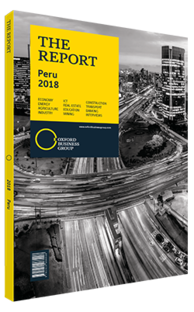Growth in Peru's manufactured exports led by chemicals subsector
After several years of decline, industrial exports grew by 10.3% in 2017 to reach $4.8bn. This was due to a 4.3% increase in the shipment of chemicals, which hit over $1.4bn, and a 16.8% rise in iron and steel to total $1.2bn. These encouraging figures continued through to 2018. The Association of Exporters (ADEX) reported that industrial exports amounted to $1.3bn in the first quarter of 2018, up 16% over the same period of 2017.
The chemicals subsector led industrial exports between January and March 2018 with a total of $374m. Iron and steel shipments ranked second with a value of $333m. Garments were third, with sales of $224m, followed by metal and mechanical goods with $145m, and textiles with $99m.
The industrial materials that were exported during the first quarter of 2018 included non-alloy zinc, refined copper wire, cotton t-shirts, steel bars, zinc oxide, crude silver alloy, polymers from propylene plates and sheets, fine alpaca hair and jewellery.
According to the ADEX Data Trade Commercial Intelligence System, the US was the number-one destination for Peruvian industrial products in 2017. Colombia, Bolivia, Chile and Ecuador were also among Peru’s top export destinations, representing 58% of registered turnover.
Competition
Juan Varilias, president of ADEX, told local media in February 2018 that although companies are starting to recover thanks to the diversification of markets and products, further efforts are needed to handle increased competition. In the same month Carlos Posada, former deputy minister of foreign trade, told local press that there are internal logistical and competitiveness barriers that prevent greater use of trade agreements.
Although companies in the textiles sector, for example, are among those that invest the most in the country, “they cannot compete because there are labour and tax surcharges, excessive regulations and bureaucratic obstacles, so they face cost overruns that other countries do not have”.
Trade Agreements
Peru’s industrial sector has become less competitive than its Asian counterparts, but recovery might not be achievable with differentiated tax rates. A joint feasibility study carried out in September 2016 classified Peru as a good supplier of raw materials necessary for the “Made in India” initiative, though not for non-primary products. According to an analysis by the National Society of Industries (Sociedad Nacional de Industrias, SNI), a trade agreement with India will perpetuate an unequal and unfavourable relationship.
Though there are more than 20 approved bilateral and multilateral trade agreements, some people have taken opposing positions as to their benefits. Some observers have attributed the 8.2% rise in non-traditional exports to $11.7bn in 2017 to free trade agreements (FTAs). However, critics argue that they have benefitted only a small sector of the economy. “The FTAs have not represented a significant increase in the export of manufactured products, benefitting almost exclusively a sector of non-traditional exports, such as agro-industry,” Silvia Hooker, foreign trade manager at SNI, told local press in February 2018.
Peru is at a disadvantage when facing large industrial competitors, according to Claudia Marchini, country manager at water treatment and chemicals distributor IXOM. “One of the primary challenges that numerous industries – particularly chemicals manufacturing – face is that output is low compared to other countries in the region, which acts as a deterrent to investments in research and development,” Marchini told OBG. Speaking to OBG, Francisco Grippa, senior economist at BBVA Research, said that making the labour market more flexible was an important step, but warned that reducing specific taxes would only help at a superficial level.
You have reached the limit of premium articles you can view for free.
Choose from the options below to purchase print or digital editions of our Reports. You can also purchase a website subscription giving you unlimited access to all of our Reports online for 12 months.
If you have already purchased this Report or have a website subscription, please login to continue.

